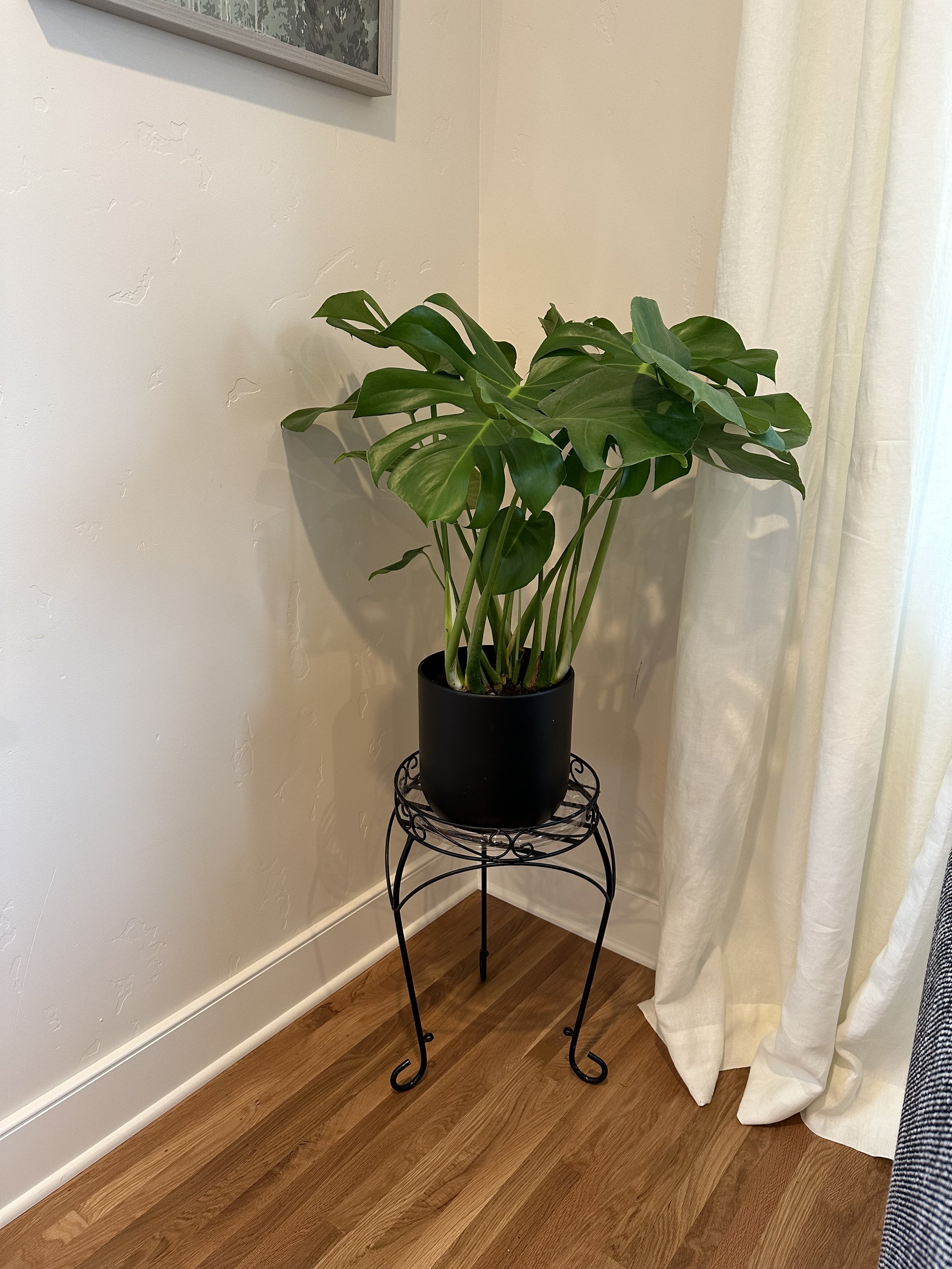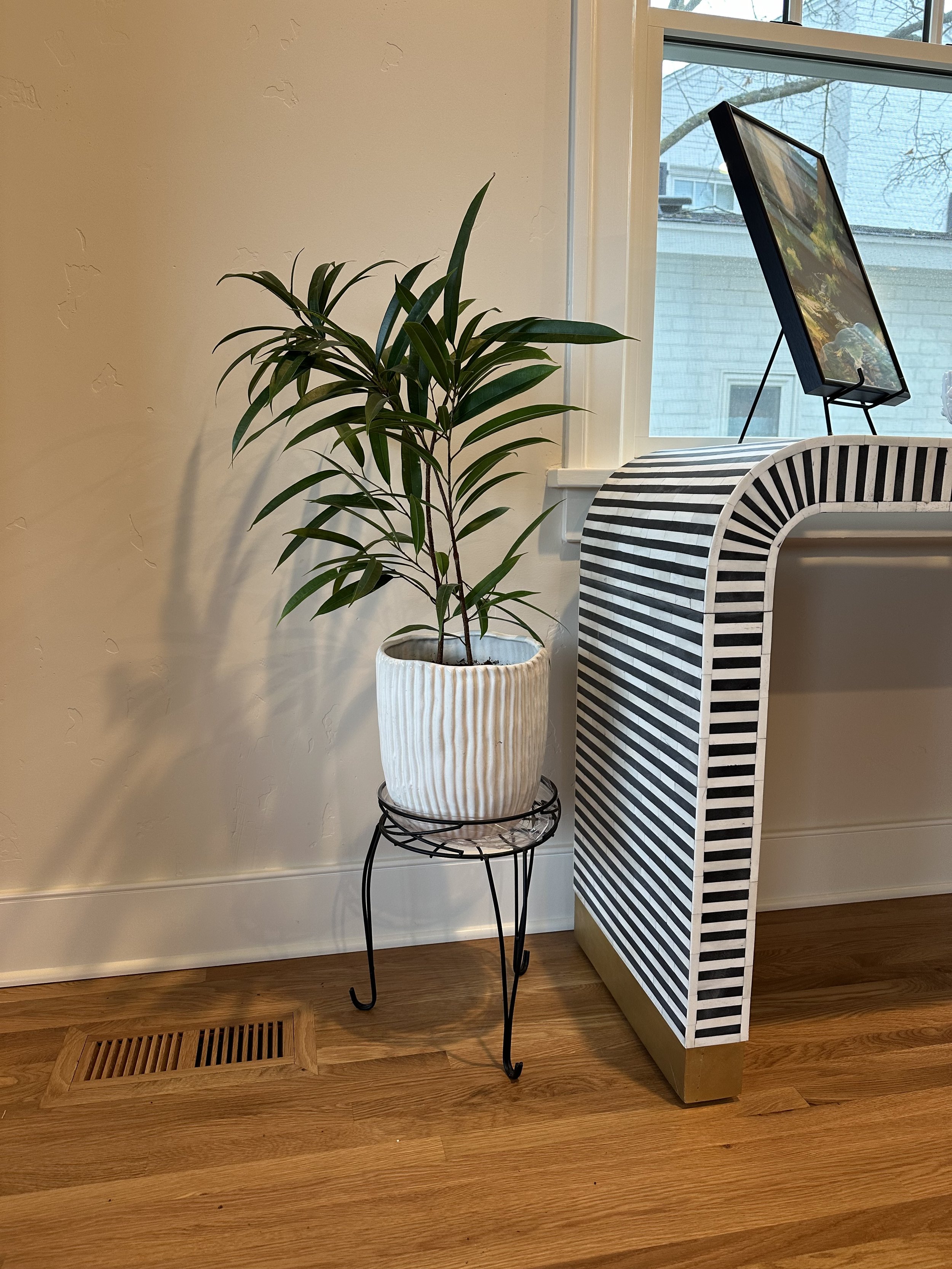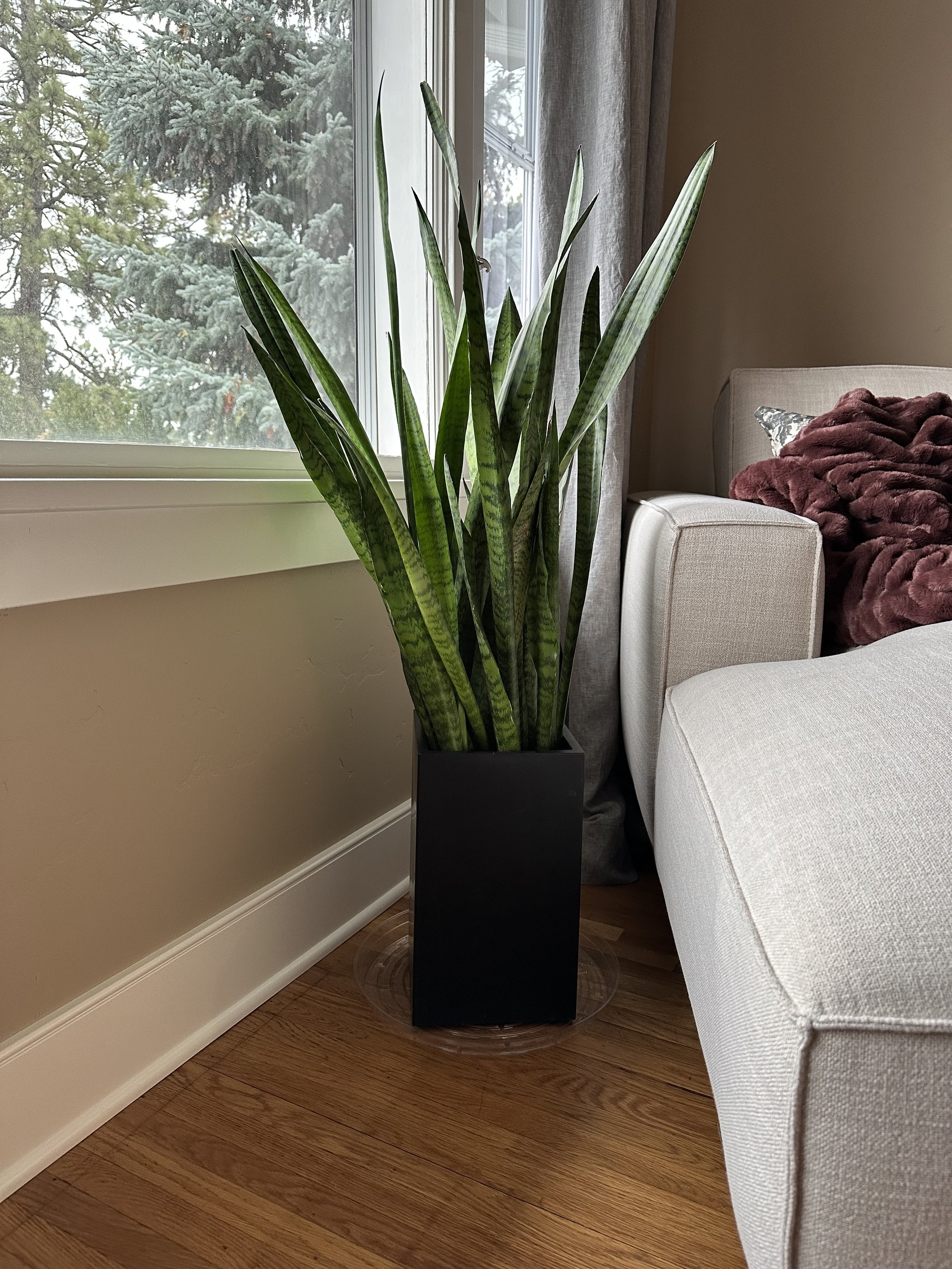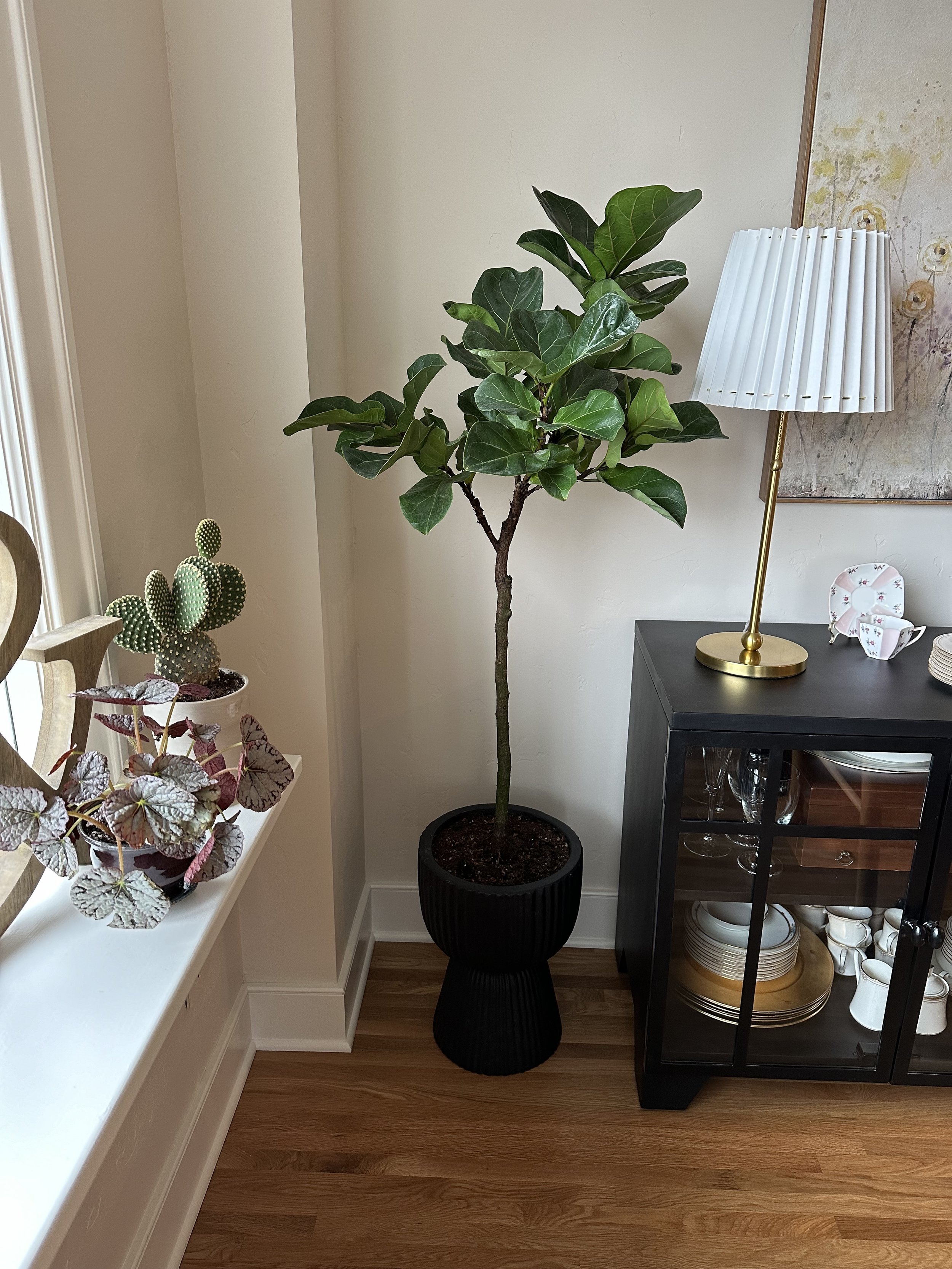HOUSEPLANT CARE GUIDE
personalized just for you.
here’s all of our top tips and tricks for keeping your new green babies healthy and thriving all year-round! from watering to fertilizing, we’re here to help you become the best plant parent possible.
Checking in… :)
We hope your plant babies are starting to settle in and push out beautiful new growth. If not — don’t worry yet!
It takes them a little time to acclimate. That can mean weeks, months or even a year in some cases. But eventually, if we take the time to listen to their needs, they will thrive in their newfound homes!
Here’s a few reminders in the meantime…
Rotate all your plants that seem to be growing funky or towards a window. This process is called phototropism. The hormone auxin gathers on the shaded side of the stem and essentially causes our green babies to dance their buns off towards the light. Since we don’t have 360 sunlight indoors like they might receive outside — rotating them bi-weekly helps them stay even and bushy. AKA not leggy and wonky as heck.
Yellowing leaves IS NATURAL AND OKAY! This happens in nature and is nothing to stress out about. They have to rid of their old leaves and sometimes it isn’t pretty. Just keep an eye on the plant and remove all of the dead foliage so the plant can focus its energy on healthy new growth.
March is great for fertilizing! The weather is warming up and the days are getting longer. Make a cute little task of it! I like to wipe down pots and clean out all of my trays and saucers and fertilize in the same day, it feels like a spa day for your green babes!
Touch their soil, look at them every day, take pictures, tell them you love them ت

THE WELCOME PHASE
In the first few days, weeks, maybe even months — your plant babies are going to be going through an acclimation phase. Sometimes that means yellowing or droopy leaves, but it’s important to stay attentive and consistent while they settle into their new spaces.
Which leads me to the most important topics, sunlight & watering.
It’s really tough because I wish I could give you a schedule and just say water this plant at this exact time every week but, as you will find out, indoor gardening can be really tricky. We’ve taken them out of any sort of natural eco-system, and it can weaken or ‘slow’ the plant quite a bit. (This is why nutrients/fertilizing and proper sunlight exposure are so so important!)
Here in the northwest, as you know, our days are dark and short. When in their native habitat, a lot of these plants would be smothered in tropical rain and bathed in sun all year-round. Our goal is to replicate that for them the best we can.
Be sure to keep your plants as close to the windows as possible, without touching any cold glass. They like bright indirect light and as much warmth as possible.
Water thoroughly and evenly, and let the soil dry out in between waterings(depending on specific plant variety). Meaning, watering until you see it pouring out of the bottom, let the plant settle AKA drink up, and then give it one more big gulp to ensure you’ve watered all roots fully. Depending on the plant, size, etc., you may need to do this a couple times to fully submerge the plant. The smaller the plant, the less amount of soil in the planter. Which means it will dry out much quicker.
If you’re watering trees or extra large plants, I like to give them a full pitcher then wait a few to 24 hours to check to see how moist the soil still is. If it feels dry at all still, I would go ahead and give it another pitcher. Large plastic trays make watering and the messes that can accompany it just a little bit easier to manage, also.
Rinsing trays frequently, wiping or dusting off leaves & planters and always using clean tools will help keep your plant babies disease and pest-free.
Dracaena ‘Janet Craig’
Native to tropical Africa, this is an indoor houseplant staple. It is widely known for being highly adaptable to many light levels and soil conditions, which makes it great for beginners. It is very drought tolerant and temperature resilient.
It prefers bright indirect light and even thorough waterings. Let the top 4-5 inches dry out completely before watering again. In your case, it will most likely be about every 20-27 days. Fertilize quarterly and keep the leaves dust-free.
Ficus Lyrata ‘Fiddle Leaf Fig’
These lush beauties can be tricky but once you both have gotten to know each other a little better, they are magnificent house guests and look absolutely stunning. Don’t stress out if you see any yellowing or browning during acclimation, especially towards the bottom. They will shed what’s needed in order to push out healthy new growth.
Ficus love even bright light. They thrive in conditions between 65-85 degrees, and they’re not a huge fan of drastic changes in their temperature. They prefer not to dry out completely, but they are also relatively sensitive to any sopping soil conditions. Check its soil weekly, and only water once the top 2 inches of soil have dried out. It will most likely be every 15-25 days.
TIP! Stick your finger an inch or two down into the soil to start learning what it feels like when it is dry, and what it feels like when it’s wet. If you notice the soil is wet days or weeks after watering, it’s being overwatered. Be sure to wait another week and let the plant dry out fully before watering again. Never let them sit in puddles of water — they will die very quickly. If you notice the plant is drooping or declining big time before every watering, water 5-7 days sooner than usual and see if that helps.
Ficus Lyrata ‘Little Sunshine’
-

Monstera 'Deliciosa'
These fast-growing beauties love bright indirect light and very well-draining soil. They’re known for their beautiful fenestrated leaves and their easy care. They are prone to rotting if they get over watered so be sure to keep an eye on those top few inches of soil before watering again. It will most likely be every two weeks. Fertilize quarterly.
-

Ficus 'Maclellandii'
Also called Ficus ‘Alii’ (all-ee-eye) these beauties are a little harder to come by. They are native to Southeast Asia, India, and China. They sometimes can be found with braided stems and can grow into stunningly massive trees. Cousin to the Ficus Lyrata — they love bright light and evenly watered soil. They’re tropical so they really don’t like drying out too much in between waterings. Fertilize quarterly.
-

Peperomia Obtusfolia 'Variegated'
With the hundreds of varieties, Peperomia will always be a top favorite houseplant. They’re really easy care and very forgiving. They love light of all kinds — they can handle a little more bright direct sun and also will thrive in a shady spot a few feet back from the window. Once their leaves get a little wobbly or malleable, they’re ready for a deep watering.
-

Sansevieria 'Zeylanica'
Snake plants are the ultimate beginner friendly green baby. Recently reclassified into the Dracaena family — they’re hardy AF. They are native to South Africa, mainly Kenya, Tanzania and Zanzibar. They don’t like to be watered very often which makes forgetting about them really easy. Give them a sunny spot and let them do their thing. Same thing as Peperomia, their leaves will become weak when they’re ready for a watering.
Phalaenopsis ‘Mini Orchid’
These gorgeous ornamental flowering plants are stunning and funky as heck. Typically, they will bloom once a year for about three months. After blooms have died and fallen off, you can cut old stem down to the base and continue to water as usual. The blooms will become more and more prolific each year and can vary in color too!
Water thoroughly every week, allowing the bark to dry in between waterings. Keep in a bright sunny spot, even if blooms have faded. Be sure to fertilize quarterly!
Native to India, China, & Southeast Asia.
Water your cacti garden thoroughly, once a month.
Since it doesn’t have a drainage hole, be sure to only give it 14-16 oz of water. I like to water with a watering can really slowly so I can make sure it doesn’t overflow. You can fertilize with the rest of plants.
Once they outgrow this pot, each one can be potted up in it’s very own pot to stretch out.
Really love one of these buddies? Just ask me it’s name! :)
Blue Myrtle Cactus
These funky blue-hued cacti are really fun to watch grow. They warp and change shape over time as they mature, branching out and creating a more candelabra-like shape. In their late adult stages, they will actually form a trunk and become a shrub.
They are extremely drought tolerant and can handle long periods of cold temperatures as low as 25 degrees. Which makes them absolute tanks in the houseplant department!
Water thoroughly once a month and fertilize quarterly!
Native to the warm and dry areas of Mexico.
-
Fox Farms ‘Big Bloom’
OR
Joyful Dirt
-
Fox Farms
Black & Gold
Rosy Soil
Espoma Organic Orchid Mix
-
The Chop Shop
Northwest Seed & Pet
Ritters Garden & Gifts
The Greenery @ SCC
Skyline Wholesale
-
Captain Jack’s Dead Bug Spray
Dr. Bronner’s Pure Castile Soup + water








